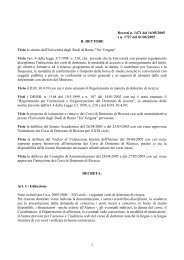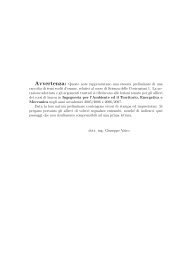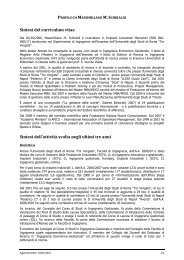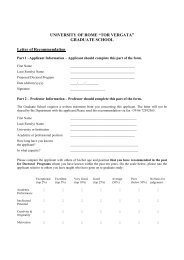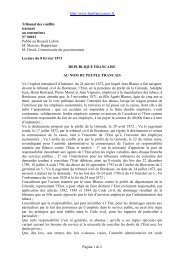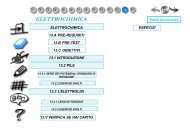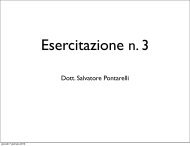Puneet Khandelwal, Soman N. Abraham and Gerard Apodaca
Puneet Khandelwal, Soman N. Abraham and Gerard Apodaca
Puneet Khandelwal, Soman N. Abraham and Gerard Apodaca
Create successful ePaper yourself
Turn your PDF publications into a flip-book with our unique Google optimized e-Paper software.
Purinergic signaling pathways as modulators of umbrella<br />
cell membrane traffic. Ferguson et al. (62) were the first to<br />
report that the uroepithelium releases ATP from its serosal<br />
surface in response to stretch. Subsequent studies found that<br />
ATP is released from both surfaces of the uroepithelium (136,<br />
225), <strong>and</strong> this release is blocked by inhibitors of vesicular<br />
transport, connexin hemichannel activity, ABC protein family<br />
members, <strong>and</strong> nucleoside transporters (115, 225). Because<br />
many of the drugs employed in these studies are not specific,<br />
the exact mechanism(s) of ATP release remains an open<br />
question.<br />
The ATP released by the uroepithelium may act in an<br />
autocrine manner by binding to uroepithelium-associated P2X<br />
receptors, which then alter uroepithelial functions. For example,<br />
stretch-induced exocytosis is inhibited by addition of<br />
apyrase (a membrane-impermeant ATPase) or the purinergic<br />
receptor antagonist pyridoxal phosphate-6-azophenyl-2�,4�disulfonic<br />
acid to the serosal, but not mucosal, surface (225).<br />
Increased exocytosis is observed on addition of ATP or purinergic<br />
receptor agonists to the serosal or mucosal surface of the<br />
uroepithelium, even in the absence of pressure (225). However,<br />
Lewis <strong>and</strong> Lewis (136) only observed small changes in exocytosis<br />
in response to exogenous ATP. Consistent with a role<br />
for P2X receptors in uroepithelial membrane traffic, bladders<br />
of KO mice lacking expression of P2X2 <strong>and</strong>/or P2X3 receptors<br />
fail to show increases in apical surface area when stretched<br />
(225). Treatments that prevent release of Ca 2� from intracellular<br />
stores or activation of protein kinase A also block<br />
ATP�S-stimulated changes in exocytosis (225). These results<br />
indicate that the ATP released from the uroepithelium may<br />
bind to P2X, <strong>and</strong> possibly P2Y, receptors on the umbrella cell.<br />
In turn, downstream activation of Ca 2� <strong>and</strong> protein kinase A<br />
second messenger cascades may act to stimulate membrane<br />
insertion at the apical pole of umbrella cells. As described<br />
above, stimulation of exocytosis by ATP may require transactivation<br />
of EGFRs. In fact, ATP-induced increases in exocytosis<br />
depend on EGFR activation (unpublished observations);<br />
however, additional studies are needed to define how the<br />
signaling cascades downstream of purinergic receptor activation<br />
lead to HB-EGF cleavage.<br />
P1 (adenosine) receptors may also be modulators of umbrella<br />
cell exocytosis. All four known adenosine receptors (A1,<br />
A2a, A2b, <strong>and</strong> A3) are expressed in the uroepithelium (235). A1<br />
receptors are found on the apical surface of the umbrella cells;<br />
the other adenosine receptors are expressed along the basolateral<br />
surfaces of the umbrella cell layer. When adenosine is<br />
added to the serosal or mucosal surface of the uroepithelium,<br />
exocytosis increases; however, this response is abolished by<br />
addition of adenosine deaminase, which converts adenosine to<br />
inosine (235). Agonists of the A1, A2a, <strong>and</strong> A3 receptors<br />
increase exocytosis after serosal administration, but only A1selective<br />
agonists significantly stimulate exocytosis after mucosal<br />
administration. Antagonists of adenosine receptors, as<br />
well as deaminase, have no effect on stretch-induced capacitance<br />
increases. However, adenosine potentiates the effects of<br />
stretch when added to the mucosal surface of stretch-stimulated<br />
epithelium (235). Similar to ATP, the adenosine-induced<br />
changes in exocytosis are inhibited when EGFR activation is<br />
prevented (unpublished observations). This indicates that<br />
transactivation may be a common pathway for agents to stimulate<br />
late-stage exocytic events.<br />
THE UROEPITHELIUM<br />
AJP-Renal Physiol • VOL 297 • DECEMBER 2009 • www.ajprenal.org<br />
Review<br />
F1491<br />
Regulation of DFV exocytosis by Rab GTPases. Vesicular<br />
traffic is regulated by small Rab family GTPases, which<br />
modulate cargo selection, vesicular transport, <strong>and</strong> vesicle fusion<br />
(141). The uroepithelium expresses multiple Ras family<br />
GTPases, including Rab4, Rab5, Rab8, Rab11, Rab13, Rab15,<br />
Rab25, Rab27b, Rab28, Rab32, RhoA, RhoC, <strong>and</strong> Ras1 (38,<br />
112). Rab27b is intriguing, because it is expressed by umbrella<br />
cells <strong>and</strong> is localized to DFV (38); however, its functional role<br />
in the uroepithelium has not been described. In other cell types,<br />
Rab27 modulates the biogenesis <strong>and</strong> exocytosis of regulated<br />
secretory granules (65); in the bladder, it likely plays a similar<br />
role in the biogenesis of DFV <strong>and</strong>/or the exocytosis of these<br />
organelles. More recent studies have examined the role of<br />
Rab11a (112), which is known to regulate exocytosis in the<br />
biosynthetic <strong>and</strong> endocytic transport pathways of other cell<br />
types (34, 37, 72, 144, 208). Similar to Rab27b, Rab11a is<br />
localized to DFV, where it colocalizes with UPIIIa. However,<br />
it is unknown whether Rab27b <strong>and</strong> Rab11a are associated with<br />
identical or distinct populations of DFV. Stretch-regulated<br />
DFV exocytosis is significantly impaired in animals transduced<br />
with adenoviruses expressing a dominant-interfering mutant of<br />
Rab11a (112). Furthermore, by coexpressing mutant Rab11a<br />
<strong>and</strong> human growth hormone (hGH), a secretory protein that is<br />
sorted into DFV <strong>and</strong> secreted into the urinary space (111, 112),<br />
it is possible to confirm in situ that the Rab11a GTPase<br />
modulates DFV exocytosis. A next step is to identify Rab11a<br />
effectors that promote these events. Possible effectors include<br />
Sec15A, FIP1–5, <strong>and</strong> myosin Vb (55, 57, 124, 155, 182).<br />
Why DFVs associate with multiple Rabs is unknown; however,<br />
such redundancy is common in other cells with regulated<br />
secretory vesicles/organelles (65). There are several possible<br />
scenarios. 1) Rab27b <strong>and</strong> Rab11a act in series. Rab27b (or<br />
Rab11a) may associate with the vesicles emerging from the<br />
TGN, <strong>and</strong> then Rab11a (or vice versa) may be recruited as the<br />
vesicles mature, facilitating late exocytic events (e.g., docking<br />
<strong>and</strong> fusion of mature DFVs with the plasma membrane).<br />
2) Rab11a- <strong>and</strong> Rab27b-positive DFVs generate a hybrid<br />
organelle in a manner analogous to the fusion of Rab11apositive<br />
recycling endosomes <strong>and</strong> Rab27a-positive late endosomes<br />
in cytotoxic T lymphocytes (144). Such fusion would<br />
result in recruitment of Rab11a <strong>and</strong> Rab27b onto the same<br />
vesicles, an event that may be a prerequisite for stretch-induced<br />
exocytosis. 3) The two Rab GTPases may associate with<br />
distinct populations of DFVs <strong>and</strong>, in a parallel fashion, act to<br />
independently regulate DFV exocytosis. For example, one<br />
GTPase may modulate the early-stage exocytic events, <strong>and</strong> the<br />
other could modulate the late-stage events. 4) Both GTPases<br />
are found on all DFVs <strong>and</strong> act sequentially to promote stretchinduced<br />
exocytosis. This mechanism is analogous to the Rab<br />
conversion during endosome maturation, in which Rab5 on<br />
early endosomes recruits numerous effectors, including the<br />
HOPs complex, which serves as a guanine nucleotide exchange<br />
factor to activate Rab7 on the maturing endosomes before their<br />
fusion with late endosomes (170). These scenarios are not<br />
mutually exclusive, <strong>and</strong> sequential activation may occur in the<br />
other models as well.<br />
Fusion of DFV with the apical plasma membrane. The<br />
exocytosis of secretory granules culminates in the fusion of<br />
vesicles with their target membranes <strong>and</strong> has recently been<br />
reviewed by Sudhof <strong>and</strong> Rothman (194). Briefly, fusion is<br />
dependent on the formation of a trans-complex of target<br />
Downloaded from<br />
ajprenal.physiology.org<br />
on October 6, 2010




